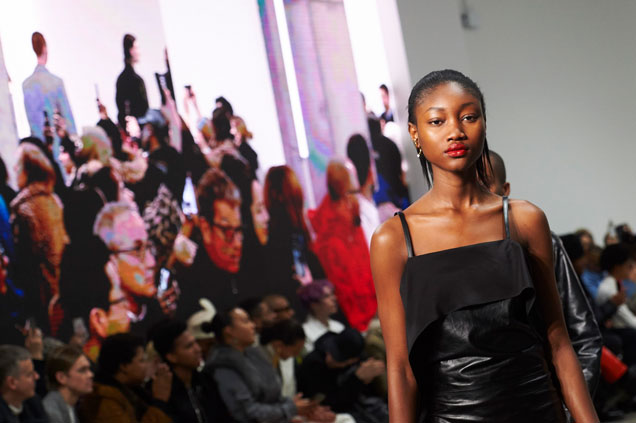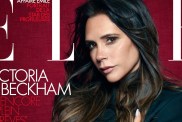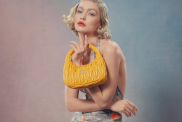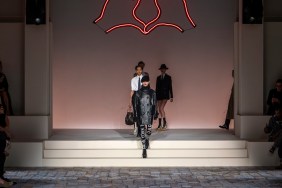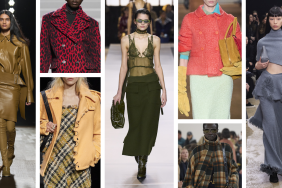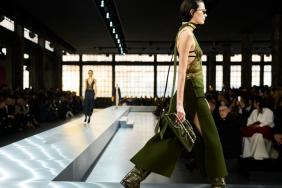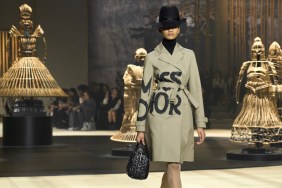This post has been updated.
Last season, the New York Fashion Week runways made significant progress in every diversity category we examine, namely race, size, age and gender inclusivity. This season, with several diversity heavy hitters — Savage x Fenty, Pyer Moss, Tome, Opening Ceremony, Calvin Klein, etc. — gone from the calendar, it was unclear whether those that remained would be able to step in and fill the absentees’ shoes. Happily, when it came to casting models of color — and, to a lesser extent, models over 50 — New York designers rose to the occasion. That said, size representation and gender inclusivity suffered greatly, a fact that does not bode well for the Fall 2019 runways overall, given that New York is reliably the most diverse of the four main fashion weeks. And so the industry’s complicated struggle with diversity and inclusivity rages on.
RACE
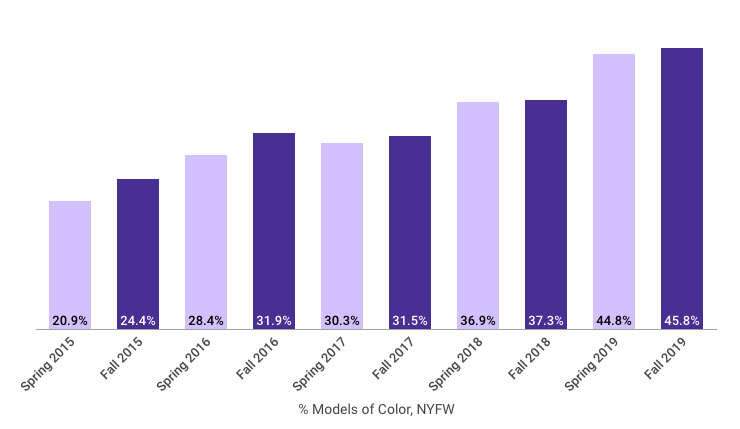
Once again, we’re happy to report that the New York Fashion Week runways were more racially diverse than ever before. After reviewing 77 major shows and 2,197 model appearances, we found that 45.8 percent of the models cast in New York shows were women of color — in other words, nearly half. True, that’s only a slight (1 point) increase from Spring 2019’s 44.8 percent, but progress is progress and now that our stats are closing in on the 50 percent mark, there’s less room for monumental leaps and bounds.
Also, let’s not forget that back in Spring 2015, when we first began tracking runway diversity, New York shows were only 20.9 percent racially diverse. Ten seasons later, the percentage of nonwhite models on the city’s runways has more than doubled.
What’s more, this is the first season wherein nonwhite models have accounted for over 45 percent of castings and the fifth to see every New York runway show feature at least one model of color.
TOP MODELS
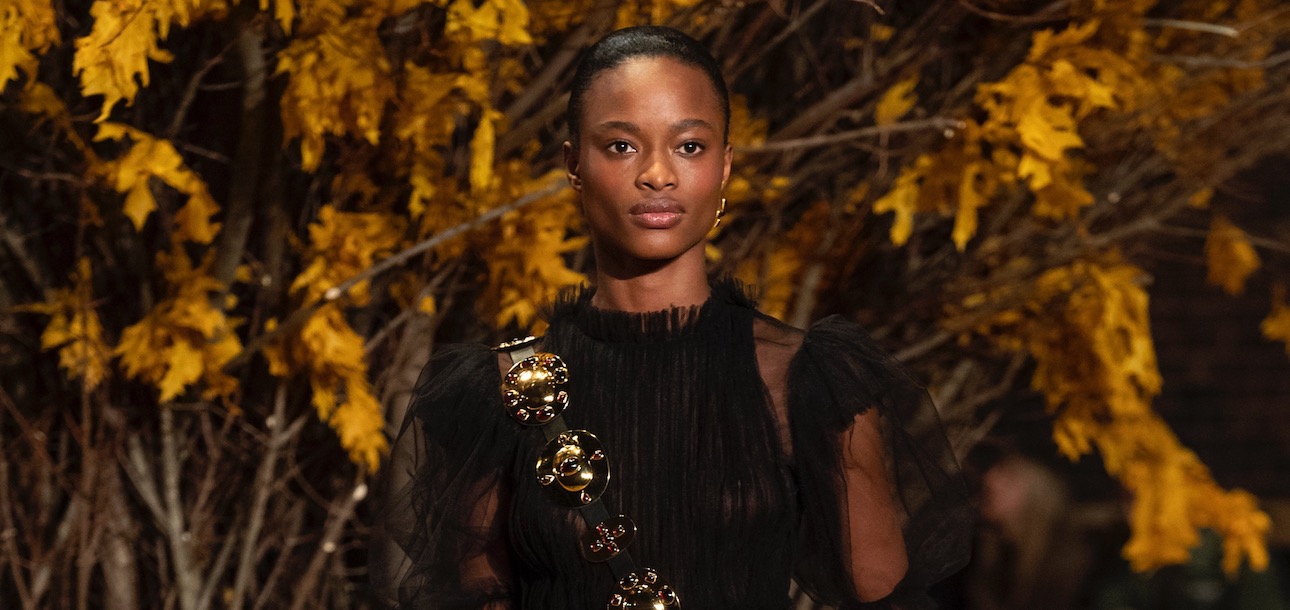
Last season, more than half (seven) of the 11 models who racked up the most New York Fashion Week runway appearances were nonwhite. For Fall 2019, all but one of the season’s 10 most-booked models were women of color. The exception? Louis Vuitton regular Cyrielle Lalande (of France), who tied Nigerian-born Mayowa Nicholas for the top spot. Each appeared in 13 Fall 2019 shows.
Second place was a four-way tie between Korean model Hyun Ji Shin, Chinese-Nigerian model Adesuwa Aighewi, Chinese model Sijia Kang and East London native Hannah Shakespeare, each of whom booked 12 shows apiece. The remainder of the list, which includes Dominican model Anyelina Rosa, Angolan model Blésnya Minher, Gambian model Fatou Jobe and Chinese model He Cong, booked 11. Per tradition, gender, size and age diversity were completely absent from the top 10 list, although one trans model (Massima Lei) did come somewhat close to the cutoff with five runway appearances.
All in all, New York’s top 10 models serve as further evidence that this was the most inclusive season ever, at least in terms of race.
PLUS-SIZE
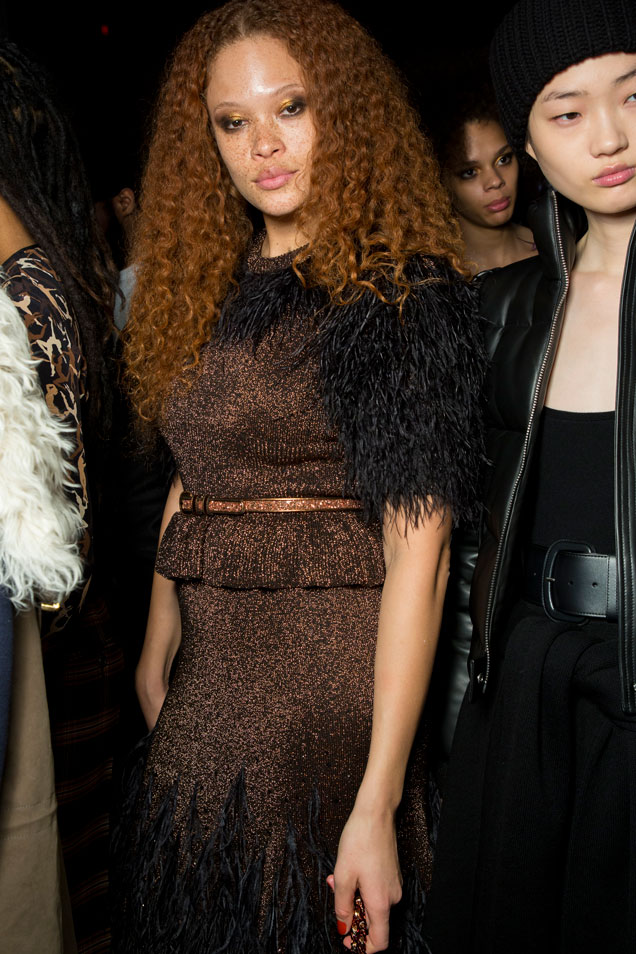
Sadly, on the body diversity front, the results were decidedly less optimistic. After an encouraging Spring 2019 season that saw 49 plus-size models (2.2 percent) walk in a total of 12 shows, Fall 2019 featured only 37 plus-size models (1.7 percent) across — again — 12 runways. Even so, it was the second-most size-diverse season yet, the first being Spring 2019, the third Spring 2018, which had 34 castings between 12 shows (1.3 percent). Perhaps as disappointing as the decline in plus-size castings is the fact that in recent seasons the roster of designers hiring non-straight-size talent has hardly grown at all.
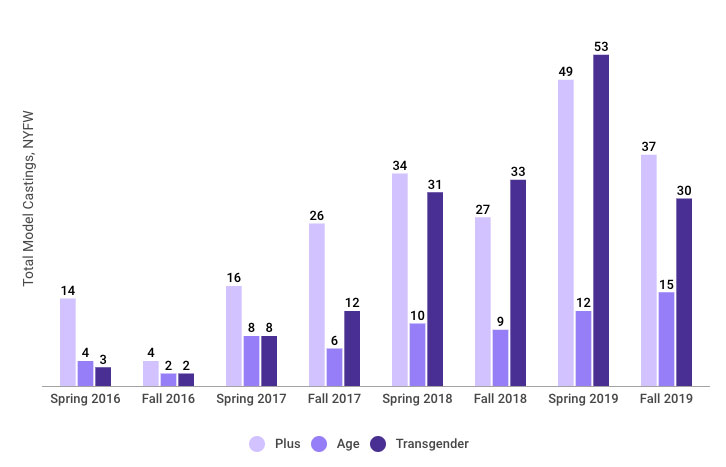
Note: For multiple reasons, we omitted plus-size luxury retailer 11 Honoré’s multi-designer showcase from our data. First, unlike the 77 shows we reviewed, 11 Honoré did not present a singular in-house collection. Our second concern was consistency: the instantly shoppable, Shopify cosponsored event was a one-off. Still, we’d be remiss not to acknowledge the most size-inclusive runway of the season: 11 Honoré’s lineup featured 35 models size 12 and above, among them Candice Huffine, Marquita Pring, Precious Lee, Stella Duval, Tara Lynn and 55-year-old supermodel Emme. (In other words, women of all sizes, shapes, ages and ethnicities.)
As far as designers go (setting aside the 11 Honoré show), Christian Siriano featured more size diversity than any other New York-based brand. As has historically been the case, Siriano was responsible for a significant chunk (over one-fourth) of the season’s non-straight-size castings. Ten plus-size women — Pring, Huffine, Ingrid Medeiros, Chloe Vero, Lee, Abbie Fleener, Alessandra Garcia Lorido, Yvonne Simone, Ashley Graham and Mia Kang — modeled the Project Runway host’s rhinestone-heavy collection.
Trailing closely behind Siriano, with nine non-straight-size castings, was Becca McCharen-Tran of Chromat, whose oil-slicked lineup included Emme, Medeiros, Kang, Ericka Hart, Priscilla Huggins Ortiz, Victoria Gomez, Veronica Pomeé, Hayley Foster and Kimberly Drew. Needless to say, Siriano and McCharen-Tran really deserve equal due — while the vast majority of designers still cast exclusively straight-size women, these two put forth size-diverse runways every single season and have played a pivotal role in evolving the conversation around sizeism in fashion.
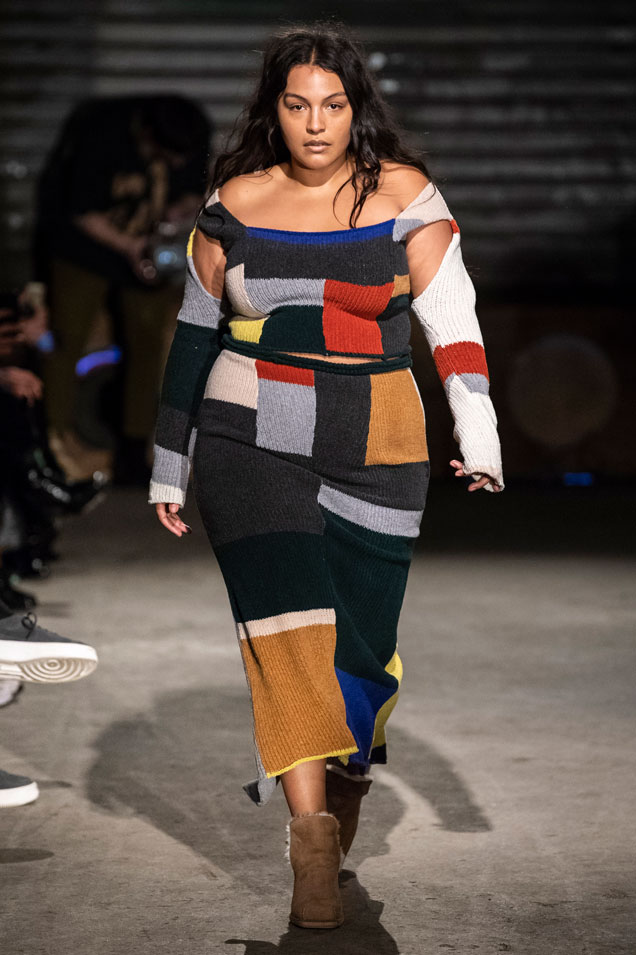
On a related note, Rio Uribe of Gypsy Sport, another prominent voice in the industry-wide push for democratized runways, hired three non-straight-size models: Hart, makeup artist Raisa Flowers and transgender model, actress and activist Jari Jones. (Jones was the only trans plus-size casting of the week.)
New York’s 15 remaining non-straight-size castings came courtesy of Tadashi Shoji (Pring, Ali Tate and Karoline Bjornelykke), Prabal Gurung (Pring and Graham), Cushnie (Pring and Huffine), Area (Betsy Teske and Tehya Elam), Michael Kors Collection (Sabina Karlsson), Yuna Yang (Sara Ghazanfareeon), Burnett (which had two, including Tate), Eckhaus Latta (Paloma Elsesser) and Maryam Nassir Zadeh (also Elsesser). Again, many of these brands — namely Cushnie, Prabal Gurung, Michael Kors Collection, Yuna Yang and Eckhaus Latta — have made size diversity a priority for several seasons now. To wit: This is the fifth season in which both Kors and Gurung have hired at least one fuller-figured model, Elsesser’s appeared on the Eckhaus Latta runway four times and last season, two non-straight-size models walked at Yuna Yang, three at Carly Cushnie’s first solo show.
Some exciting news: looking at intersectionality, more than two-thirds (25) of New York Fashion Week Fall 2019’s 37 plus-size model appearances went to women of color. One went to a plus-size woman over the age of 50 (Emme at Chromat — again, we’re not counting her turn at 11 Honoré). Additionally, Fall 2019 marks the first season in recent memory that a transgender plus-size model walked in New York (at Gypsy Sport).
Overall, when it comes to size representation, the industry is making progress in certain areas, but falling woefully behind in others. While the number of non-straight-size magazine cover stars shot from eight (1 percent) to 18 (2.4 percent) between 2017 and 2018, the most recent (Fall 2018) seasonal ads — “perhaps the most consumer-facing form of fashion imagery,” as Fashionista puts it — featured just seven plus-size models (1.3 percent), the lowest turnout we’ve seen since 2015. Coupled with Fall 2019’s decline in plus-size runway castings, it’s clear fashion brands (and casting directors) still have their work cut out for them.
TRANSGENDER/NON-BINARY

New York Fashion Week’s Spring 2019 season marked a new level of inclusivity for the LGBTQ+ community: more openly transgender women and non-binary models walked than ever before. Unfortunately, that progress did not hold. For Fall 2019, we saw our first regression in trans and non-binary castings since Fall 2016. (For those doing the math, that was seven seasons ago.) Of the 2,197 runway appearances we tracked, 30 (1.4 percent) went to trans women and non-binary models. To break it down, 21 trans women and nine non-binary models were cast among 17 shows.
We should mention that actress and transgender icon Laverne Cox closed the 11 Honoré show. So, if the show had fit our criteria, Fall 2019’s trans/non-binary castings would clock in at 31.
Either way, that’s a significant drop-off from Spring 2019, when a record 53 trans and genderqueer models (49 trans, four non-binary) were cast between 20 shows (2.41 percent) and nearly on par with Fall 2018 when 33 trans women and non-binary models (28 trans, five non-binary) walked in 23 shows (1.44 percent). It’s also the lowest figure we’ve seen since the Spring 2018 season when runway regular Teddy Quinlivan — who was curiously absent from New York’s Fall 2019 shows — chose to reveal her transgender identity.
As for the brands doing the heavy lifting, Gypsy Sport wins, yet again, for the most gender-inclusive runway of the season. “I wanted to prove that truly every body can wear lingerie,” Rio Uribe told Vogue. To that end, the sustainability-minded designer outfitted six trans women and two non-binary models — including Munroe Bergdorf, Connie Fleming, Richie Shazam and the aforementioned Jari Jones — in his upcycled, boudoir-worthy fall collection.
Chromat, the second-most size-diverse show of the season, was also the second-most gender-inclusive with four trans and/or non-binary runway stars. Seasoned Chromat alums Maya Monès, Geena Rocero and Carmen Carrera returned for Fall 2019, this time joined by non-binary model Eddie Jarel Jones.
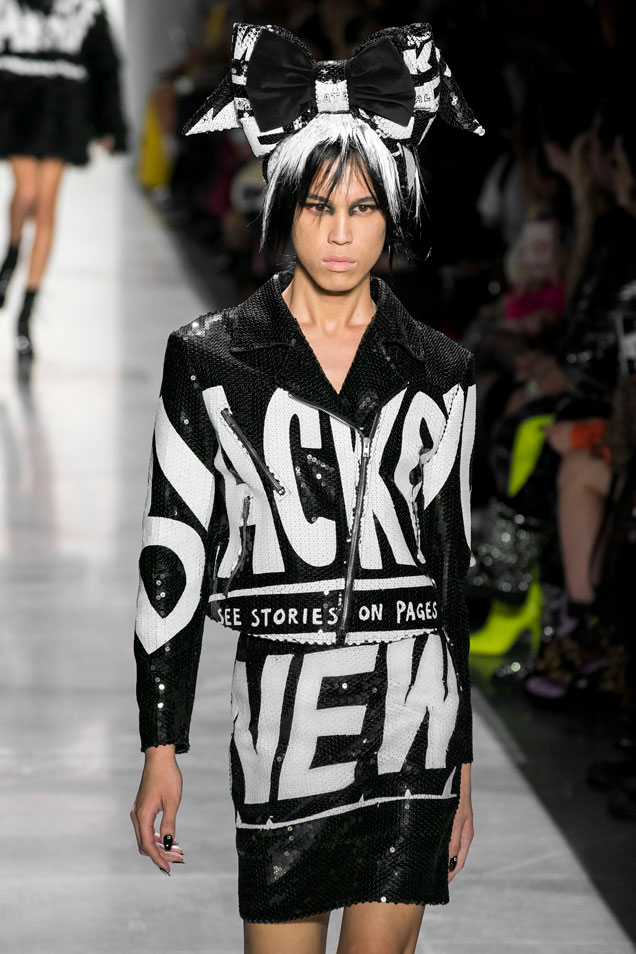
Eckhaus Latta and The Blonds, also typical leaders in this category, hired two trans and/or non-binary models each. Sara Oliver Wight and Oslo Grace walked in Mike Eckhaus and Zoe Latta’s knit-heavy show; Pose’s Mj Rodriguez took a turn at The Blonds, as did Phillipe Blond, the brand’s (non-binary) co-founder and designer.
With Quinlivan on hiatus, Next’s Massima Lei was easily the most popular of her transgender peers, landing five New York Fashion Week Fall 2019 appearances (at Gabriela Hearst, Priscavera, Marina Moscone, NPC and Burnett). Non-binary model Noah Carlos (of IMG, naturally) was a favorite among the more mainstream set, walking at Helmut Lang, Sies Marjan and R13. Compared to Spring 2019, Dara Allen had a relatively quiet season, making one appearance (at Jeremy Scott). Ditto for Hunter Schafer, who returned for a second season at Coach 1941. Finally, Prabal Gurung hired Maarten Covens, Vivienne Hu non-binary model Layla Sharifi, Korean designer Yuna Yang non-binary twins Joseph and Jake Dupont.
Encouragingly, a large majority (17) of the week’s 30 trans and non-binary castings went to people of color, one to a nonwhite, non-sample-size trans woman (Jones). Still, no designer booked a trans or non-binary model over the age of 50. What’s worse, several New York Fashion Week heavy hitters — we’re looking at you, Marc Jacobs, Proenza Schouler and Kate Spade New York — failed to hire any trans or non-binary models after championing the group last season. Hopefully, Spring 2019’s embrace of trans and gender nonconforming models wasn’t just a passing trend tied to a demand for new faces. Time will tell and in the interim, we’ll comfort ourselves with the knowledge that 2018’s magazine covers featured more trans and non-binary faces than ever before and that the Fall 2018 campaigns featured the second-highest percentage of stars in this category we’ve seen to date.
An aside: While we’re on the subject of LGBTQIA+ representation, we’d like to point out that drag performers enjoyed significantly less popularity this season than last, when a total of 25 walked in three shows: Opening Ceremony, The Blonds and Gypsy Sport. For Fall 2019, Opening Ceremony skipped New York Fashion Week, adopting a (Lunar New Year) party-as-presentation strategy, and between The Blonds and Gypsy Sport, only three drag performers were cast. (RuPaul’s Drag Race winner Aquaria at The Blonds; New York ball legend Kevin Aviance and model/artist Serena Tea at Gypsy Sport.)
AGE
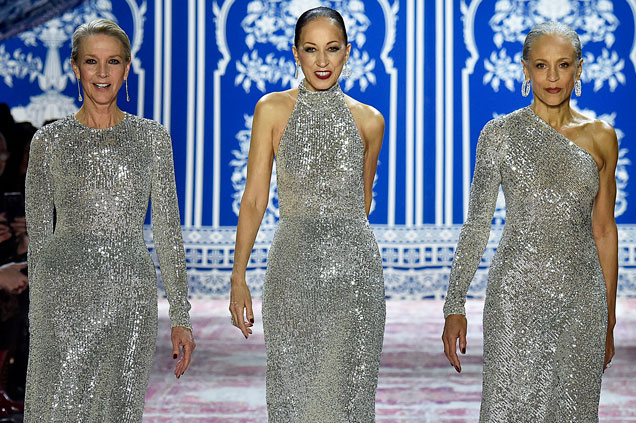
Per usual, women age 50 and above were the least represented of all the groups. Such has been the case for the past five seasons (starting in Fall 2017, up to and including Fall 2019). That said, this was the only category outside of race to see any sort of improvement, however slight. New York’s Fall 2019 season had 15 (0.68 percent) 50-and-over castings, compared to 12 (0.54 percent) in Spring 2019 and nine (0.39 percent) in Fall 2018, making it the most age-diverse season on record.
New York’s move toward greater age inclusivity came at the hands of 13 designers — some establishment, some new guard. (For comparison, in Spring 2019, only seven made the effort.) The former seemed intent on tapping into fashion’s nostalgia-fueled supermodelmania: Christy Turlington walked for American fashion titan Marc Jacobs, Pat Cleveland for Hellessy, Patti Hansen for Michael Kors Collection, Carol Alt for Dennis Basso, Christie Brinkley for Elie Tahari. Perhaps most notably, former Halston apprentice Naeem Khan wowed showgoers with a surprise appearance by the legendary Halstonettes: Cleveland, Karen Bjornson and Alva Chinn closed the designer’s Fall 2019 show in fierce, figure-hugging sequin gowns.
Meanwhile, several young-ish labels continue to make age diversity a priority when it comes to selecting runway models. For Fall 2019, Eckhaus Latta, Collina Strada, Creatures of the Wind, Maryam Nassir Zadeh, Chromat, Priscavera and Burnett each hired one over-50 model. Standout moments included Emme’s fourth consecutive Chromat walk, fashion designer and artist Susan Cianciolo’s Maryam Nassir Zadeh debut (along with her return to the Eckhaus Latta runway) and stylist and former Vogue Fashion Director Tonne Goodman’s Creatures of the Wind cameo.
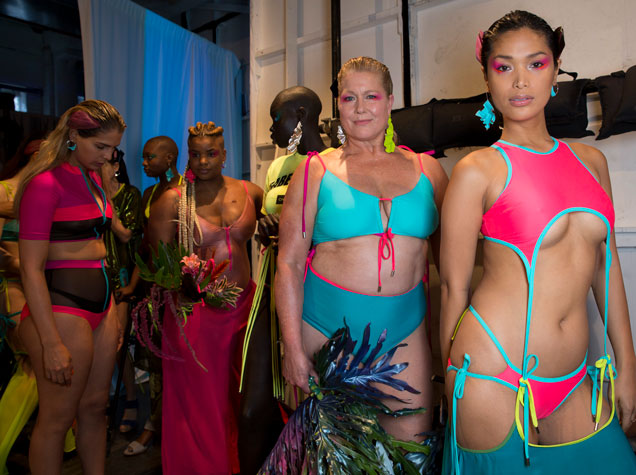
As always, few designers presented a more nuanced, multifaceted view of age diversity. For the umpteenth time, Chromat was the only brand to hire a plus-size woman over the age of 50 (Emme, who, at the risk of sounding like a broken record, also walked at 11 Honoré). And only three of the week’s castings went to nonwhite women in this age group (Cleveland and Chinn at Naeem Khan, Cleveland at Hellessy). Unsurprisingly, transgender models over age 50 were overlooked completely.
Nevertheless, it’s been a promising year for models age 50 and over. Yes, they remain the runways’ most underrepresented category, but in Fall 2019 their visibility grew despite the absence of several noted age diversity advocates — Creatures of Comfort (RIP), Opening Ceremony, Tome, Calvin Klein, J.Crew, Tracy Reese, Zero + Maria Cornejo — from the New York Fashion Week show calendar. Then there’s the fact that over-50 models were the best-represented non-race category both on 2018’s magazine covers and in the most recent seasonal ads. Plus, just from eyeballing the London and Milan collections, we’re cautiously optimistic that this slight uptick in over-50 runway castings has transcontinental legs.
MOST AND LEAST DIVERSE SHOWS

Gone are the days of tokenism, at least when it comes to racial diversity, at least on the runways of New York. For Fall 2019, nearly one-third (25 out of 77, or 32.5 percent) of New York Fashion Week shows featured lineups that were at least 50 percent models of color.
Which shows saw the most racial diversity? In descending order: Claudia Li (96 percent models of color), Gypsy Sport (94 percent models of color), Chromat (90 percent models of color), LaQuan Smith (78.3 percent models of color), Cushnie (74 percent models of color), Hellessy (72 percent models of color), Prabal Gurung (71 percent models of color), Christian Cowan (67.9 percent models of color), Brandon Maxwell (64 percent models of color), Sies Marjan (63 percent models of color), Christian Siriano (63 percent models of color), Oscar de la Renta (62 percent models of color), Tadashi Shoji (61 percent models of color), NPC (60 percent models of color), The Blonds (58 percent models of color), Anna Sui (58 percent models of color), Philipp Plein (57.1 percent models of color), Helmut Lang (56.5 percent models of color), 3.1 Phillip Lim (55 percent models of color), Pamella Roland (54 percent models of color), Tom Ford (53.8 percent models of color), Ryan Roche (52 percent models of color), Tory Burch (52 percent models of color), Self-Portrait (50 percent models of color) and Area (50 percent models of color).
Let’s take a moment to appreciate Zang Toi’s progress. In the past, the label has often ended up on our least-diverse show list. Last season, for example, the brand cast only one model of color in a lineup of 14 (7.14 percent).
Of course, there were still labels that somehow missed the boat — namely Son Jung Wan, Zadig & Voltaire and Vivienne Hu, which cast 1 out of 16 (6 percent), 4 out of 36 (11 percent) and 2 out of 17 (12 percent) models of color, respectively. (Though, to be fair, Vivienne Hu was one of the few brands to feature a non-binary model.) Thankfully, not one show was entirely white, a phenomenon that began five seasons ago at New York Fashion Week Fall 2017.
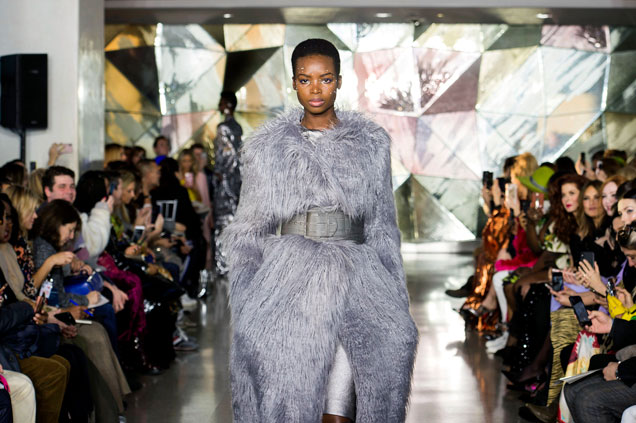
The list of brands that made it a point to feature more than one type of diversity in their show and take intersectionality into account reads much like last season’s, albeit shorter, and with fewer big names. At New York Fashion Week Fall 2019, true, all-around diversity was visible on the runways of Gypsy Sport, Chromat, Christian Siriano, Eckhaus Latta and Burnett.
As you well know by now, Gypsy Sport put diversity front and center. The brand hired 94 percent models of color, eight transgender and/or non-binary models and three plus-size models. Rio Uribe’s was the most gender-inclusive show of the season, the second-most racially diverse and among the top four most size-inclusive. Not to mention, he was responsible for the only trans plus-size — and nonwhite — casting of the week. What’s more, the show also featured one breast cancer survivor, two drag performers and artist and expectant mother Corey Wash. Bravo.
Chromat’s Becca McCharen-Tran likewise mixed models of all ages, sizes, ethnicities, gender identities and abilities. With 90 percent models of color, nine non-straight-size models and four trans and/or non-binary models, hers was the third-most racially diverse runway of the week and the second-most gender- and size-inclusive. Per usual, McCharen-Tran also brought in intersectionality: Chromat regular Emme was the only model over size 10 and age 50 to walk in New York Fashion Week. Relatedly, breast cancer survivor, amputee and Chromat returnee Mama Cax was one of the few differently-abled models cast in any show.
In addition to hiring 63 percent models of color, Christian Siriano contributed over a quarter (10) of the season’s plus-size castings, the most of any New York designer. Eckhaus Latta, while not especially ethnically diverse (with 39 percent models of color), did feature one over-50 model, two trans and/or non-binary models and one non-straight-size model (of color). Finally, New York Fashion Week newcomer Burnett (helmed by Emily Burnett, former creative director at Dennis Basso) got off to a strong start with a cast made up of 42 percent models of color, two non-straight-size models, one transgender model and one model over the age of 50. (A reminder to us industry folks mourning the week’s many mid-career designer departures of the necessity of new blood.)
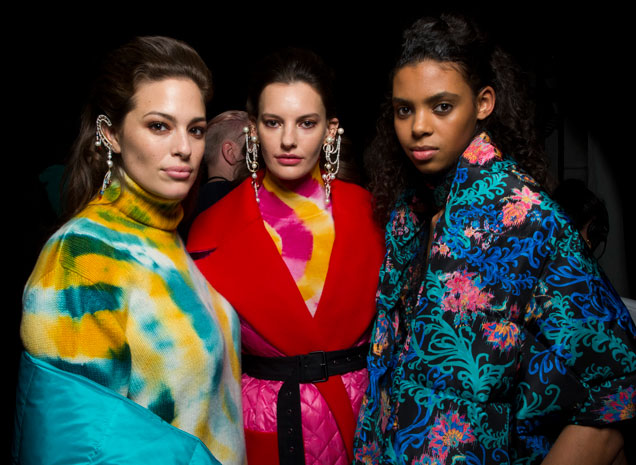
To quote The New York Times’ Vanessa Friedman: “The runway may have become the front line of diversity, but it definitely is not the end.” These days, her words ring especially true. Over the past few months, we’ve seen stark evidence that, despite what the Spring 2019 runways might have suggested, some of the biggest brands in fashion still simply don’t understand their diversity problem — we’re thinking of Dolce & Gabbana’s ads mocking Chinese speech, Gucci blackface balaclavas, the nooses that walked the runway at Burberry Fall 2019.
While it’s true we can’t expect record-breaking improvements every season, New York Fashion Week Fall 2019’s minimal improvements in racial and age diversity and the falloff of size and gender representation leave us especially ill at ease. Partly because of their contrast with last season’s stunning gains, which left us feeling like we’d reached a point of genuine change, and partly because a lack of progress on the frontlines points to an even greater problem behind the scenes. If a season that saw real inclusivity on the runways was followed by the aforementioned controversies, what have we to expect from brands in the coming months? Fashion is definitely moving toward greater inclusivity, but at nowhere near the pace demanded by the times.
Additional reporting by Mark E.
Only women and non-binary models are included in this data. Models of color are categorized as those who are nonwhite or of mixed backgrounds. Spring 2019 collections that showed during the Fall 2019 season are included in this report.
Note: Per a correction by a Prabal Gurung representative sent to Fashionista, the original version of this article was updated to reflect that 30 transgender and non-binary models walked in New York Fashion Week. We also removed Prabal Gurung from our list of designers who cast a trans model in Spring 2019 but not Fall 2019. (Trans model Maarten Covens walked Gurung’s Fall 2019 runway.)
